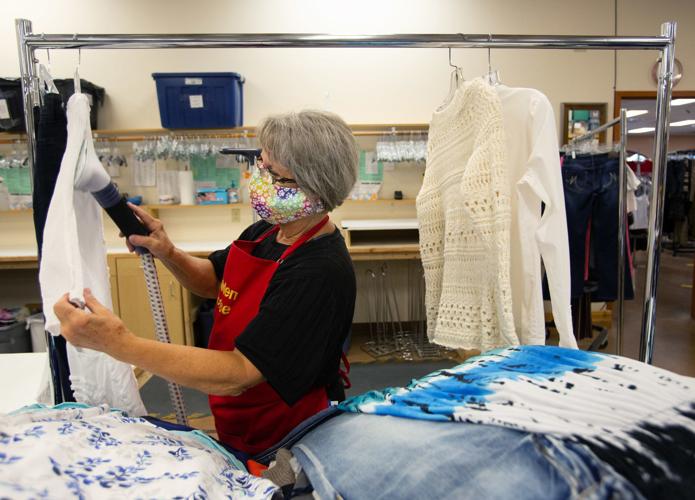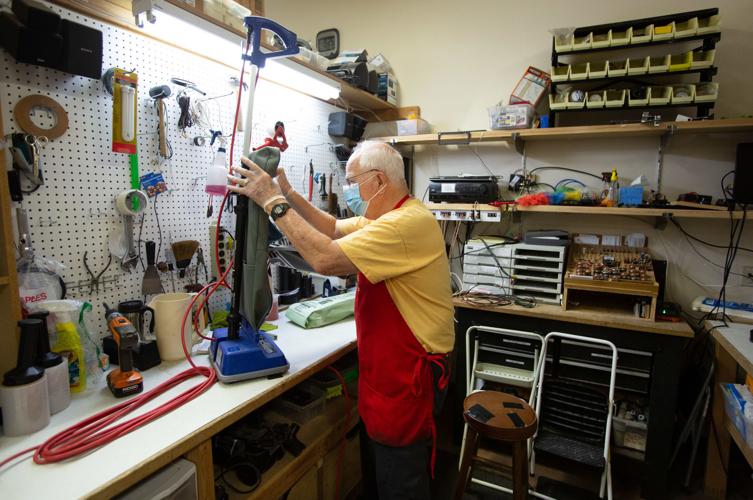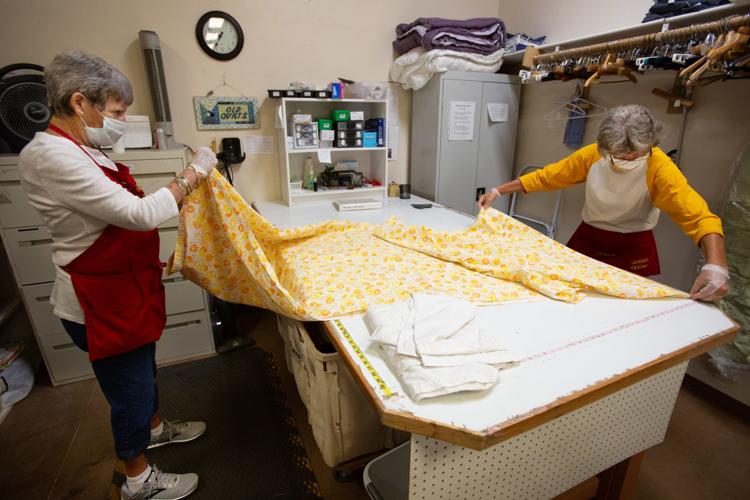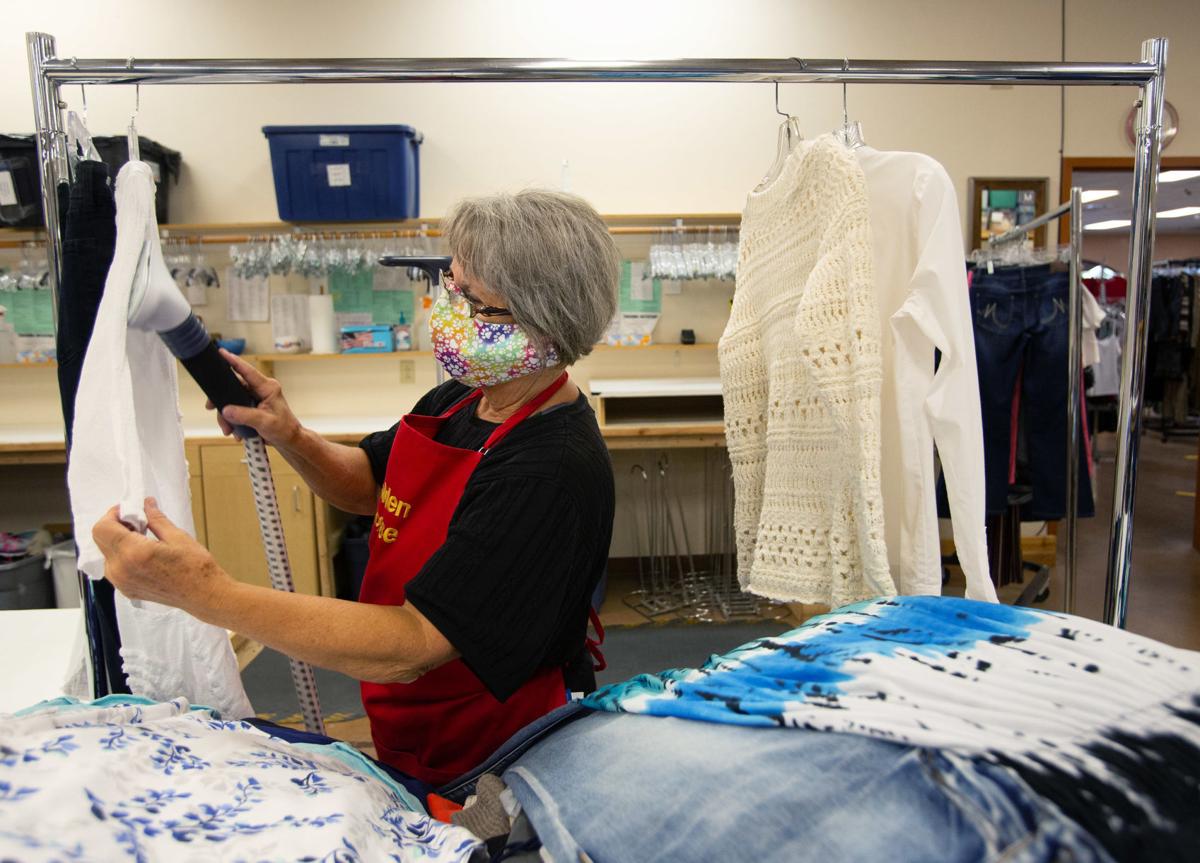When the state ordered retail shops closed in mid-March amid the COVID-19 pandemic, Gayl Van Natter was hoping to avoid layoffs at the Golden Goose Thrift Store, a nonprofit in Catalina.
She found a way in the Arizona Shared Work program, a longtime state program that allows employers to spread reduced hours across two or more workers kept on the payroll — and lets workers collect unemployment benefits for their lost hours.
Van Natter, president of the Golden Goose since 2018, was able to spread work-hour reductions across the nonprofit’s six full-time employees.
“To me, it’s an excellent program,” she said. “It allows us to keep all of our people working and whole, where we probably would have had to lay some of them off and keep the other ones whole, or at the very least cut back everyone’s pay with no supplement.”
Keeping the workers on board also has helped the Golden Goose move forward with plans to reopen on June 2, with extensive safety precautions including mandatory masks and a cap of 35 shoppers in the store.
The Golden Goose is one of about 400 employers statewide who have been approved for the Shared Work program since March 1, under special rules affording more flexibility to employers during the coronavirus emergency, a DES spokesman said.

Volunteer Dick Werling repairs an electrical connection in a vacuum and brings it back to life at the Golden Goose Thrift Shop in Catalina, Arizona.
HOW IT WORKS
The Shared Work program provides an alternative to layoffs by allowing businesses to divide available work or hours among affected employees.
The program also allows the employees to receive a portion of unemployment insurance benefits while working reduced hours.
DES has adopted some special rules to help employers and workers during the COVID-19 pandemic:
- The agency has temporarily increased the maximum reduction of hours for the Shared Work program from 40% to 60%. That means employers can reduce workers’ hours up to 60% and still qualify for the Shared Work program, as long as they continue to provide health and retirement benefits to participating employees.
- During the emergency, employers won’t get charged with layoffs that normally could affect their unemployment insurance rating and increase their future costs.
- Shared Work employees also qualify for federal pandemic unemployment compensation, which provides an additional $600 per week for eligible weekly claims from March 29 to July 25. That extra benefit is particularly important to workers in Arizona, whose maximum weekly unemployment benefit is second-lowest among the states at $240.
There are some caveats on the Shared Work program for employers who also qualify for other federal aid programs.
For example, Van Natter said, the Golden Goose also received a $63,000 loan through the federal Paycheck Protection Program, or PPP, that can be used to pay employees over an eight-week period, with the loan amount forgiven in proportion to the number of workers they retain.
But under its Shared Work plan, the nonprofit is limited to reducing work hours a maximum 25% or it could affect its PPP loan forgiveness, she said.

Volunteers Sue Hagerty, left, and Brenda Baker measure and examine donated sheets at the Golden Goose Thrift Shop, which received a $63,000 loan through the federal Paycheck Protection Program.
FLEXIBLE BUT TRICKY
Tucson attorney Tim Medcoff, who worked with the Golden Goose on its Shared Work plan, said the caveat is because under the rules for forgiving PPP loans, employers can’t reduce wages below 75% of a worker’s normal pay.
The Shared Work program has some built-in flexibility, allowing employers to share work over up to two groups of employees while still allowing them to lay others off.
“That’s a huge plus, the flexibility that it provides, and obviously it avoids laying people off,” said Medcoff, a managing partner at Farhang & Medcoff and chairman of the Tucson Metro Chamber.
“In general, employers don’t want to lose people, especially if they’ve spent a lot of time and money to get them trained, and then they have to hire someone else down the road,” Medcoff said.
Employers taking advantage of the state program ideally have groups of workers who do the same or similar tasks, so they can cover for each other during reduced hours, Medcoff said.
But Shared Work may not work for some smaller companies where each employee handles very different jobs, he noted.
SIGN UPS SURGE
DES, which has promoted the program in a newsletter to more than 230,000 employers and through partner agencies, has seen a surge in employer participation, department spokesman Brett Bezio said.
Statewide since March 1, about 400 employer Shared Work applications have been approved, representing 6,700 employees, Bezio said.
That’s a big jump from 2019, when there were about 27 employers and 500 employees participating in the program in any given month, he noted.
“We continue to promote this program among employers to encourage further participation,” Bezio said.
Arizona launched its Shared Work program in 1982 and is one of 26 states with operational Shared Work programs, also known as short-term compensation programs, according to the U.S. Department of Labor.
Photos for May 13: Tucson gets by during Coronavirus Pandemic
Tucson gets by during coronavirus pandemic
Updated
The venerable T-Rex outside the McDonald's at Grant and Tanque Verde comes around late, but strong, to the mask game, May 13, 2020, Tucson, Ariz.
Tucson gets by during coronavirus pandemic
Updated
Greg Madril, director of Pascua Yaqui Workforce Development, loads a van up with boxes of food to be taken to homes of elders on the reservation who have isolated themselves during the Coronavirus (COVID-19) pandemic, on May 8, 2020.
Tucson gets by during coronavirus pandemic
Updated
Abigail Pauley (center) and Carmen Solis (right) deliver food to the homes of elders on Pascua Yaqui Reservation who have isolated themselves during the Coronavirus (COVID-19) pandemic, on May 8, 2020.
Tucson gets by during coronavirus pandemic
Updated
Catalina Foothills High School graduates throw their hats in the air as they are videoed on the stage on the football field at Catalina Foothills High School, 4300 E. Sunrise Dr., in Tucson, Ariz., on May 11, 2020. Due to the coronavirus pandemic, Catalina Foothills High School is videoing all 415 graduates individually over three days crossing the stage with their diploma cover. Small groups of graduates are escorted toward the stage and stand next to cones set apart for social distancing. After video and still pictures, graduates are given a t-shirt as they leave. "Its an amazing amount of work and planning, but our grads are worth it," said Julie Farbarik, director of Alumni and Community Relations at Catalina Foothills School District.
Tucson gets by during coronavirus pandemic
Updated
Graduates follow directions as they are filmed cross the stage at Catalina Foothills High School, 4300 E. Sunrise Dr., in Tucson, Ariz., on May 11, 2020. Due to the Coronavirus Disease (COVID-19) and graduations being canceled, Catalina Foothills High School, set across three days, is filming all 415 graduates as they cross the stage with a their diploma cover. Small groups of graduates are escorted toward the stage and stand next to cones set apart for social distancing. After filming and taking pictures, graduates are given a t-shirt as they leave. "Its an amazing amount of work and planning, but our grads are worth it," said Julie Farbarik, director of Alumni and Community Relations at Catalina Foothills High School.
Tucson gets by during coronavirus pandemic
Updated
Catalina Foothills High School senior Maura Benesch grabs hand sanitizer before picking up her diploma cover at Catalina Foothills High School, 4300 E. Sunrise Dr., in Tucson, Ariz., on May 11, 2020. Due to the coronavirus pandemic, Catalina Foothills High School is videoing all 415 graduates individually over three days crossing the stage with their diploma cover. Small groups of graduates are escorted toward the stage and stand next to cones set apart for social distancing. After video and still pictures, graduates are given a t-shirt as they leave. "Its an amazing amount of work and planning, but our grads are worth it," said Julie Farbarik, director of Alumni and Community Relations at Catalina Foothills School District.
Tucson gets by during coronavirus pandemic
Updated
Senior students follow directions as they are videoed crossing the stage on the football field at Catalina Foothills High School, 4300 E. Sunrise Dr., in Tucson, Ariz., on May 11, 2020. Due to the coronavirus pandemic, Catalina Foothills High School is videoing all 415 graduates individually over three days crossing the stage with their diploma cover. Small groups of graduates are escorted toward the stage and stand next to cones set apart for social distancing. After video and still pictures, graduates are given a t-shirt as they leave. "Its an amazing amount of work and planning, but our grads are worth it," said Julie Farbarik, director of Alumni and Community Relations at Catalina Foothills School District.
Tucson gets by during coronavirus pandemic
Updated
A fully suited worker, part of a crew from ServiceMaster, gestures out the door to a teammate while sanitizing the Little Cesars at 1201 W. St. Mary's, May 9, 2020, Tucson, Ariz.
Tucson gets by during coronavirus pandemic
Updated
Owner Michael Elefante cleans the pasta bar at Mama Louisa’s, 2041 S. Craycroft Road. Local restaurants and bars must limit their indoor occupancy to no more than 50%.
Tucson gets by during coronavirus pandemic
Updated
Lunchtime is normally standing room only at R&R Pizza Express, 13,905 N. Sandario Road, Marana. But it was sparsely attended on May 11, 2020, as the state allowed restaurants to re-open their dining rooms. Owner Linda Molitor carefully spaced tables to maintain social distancing for dining-in.
Tucson gets by during coronavirus pandemic
Updated
Owner Linda Molitor wipes down one of four tables available for dining-in at R&R Pizza Express, 13,905 N. Sandario Road, Marana, on May 11, 2020.
Tucson gets by during coronavirus pandemic
Updated
Suzanne Elefante, center, office manager, teaches Breanna Jirschele, employee, a discount at the register at Mama Louisa's, 2041 S. Craycroft Rd., in Tucson, Ariz., on May 11, 2020.
Tucson gets by during coronavirus pandemic
Updated
Debra Roff, left, employee, keeps her distance as she takes a families order at Coyote Pause Café, 2740 S. Kinney Rd., in Tucson, Ariz., on May 11, 2020. Restaurants reopened on Monday after Gov. Doug Ducey allowed restaurants to open and the Pima County Health Department issued a list of protective measures in response to the Coronavirus Disease (COVID-19). Coyote Pause Café has decreased their seating to less than 50% to allow for social distancing along with signage about COVID-19 and social distancing. There are sneeze-guards, made by the employees, at the counter tops. There are also small trash bags placed at every table for customers to place their trash allowing employees to decrease the amount of items they touch.
Tucson gets by during coronavirus pandemic
Updated
Leo Kresch, left, and Drew Burk, employees from Downtown Kitchen and Cocktails prepare to-go meals at The Carriage House, 135 S. Sixth Ave., in Tucson, Ariz., on May 12, 2020. Janos Wilder, owner of The Carriage House and Downtown Kitchen and Cocktails, received a donation to help prepare 1,400 meals for Tucson Medical Center employees. The meal includes two entrees and a desert.
Tucson gets by during coronavirus pandemic
Updated
Devon Sanner, executive chef at The Carriage House and Downtown Kitchen and Cocktails, places Thai Green Vegetable Curry on top of rice in to-go meals at The Carriage House, 135 S. Sixth Ave., in Tucson, Ariz., on May 12, 2020. Janos Wilder, owner of The Carriage House and Downtown Kitchen and Cocktails, received a donation to help prepare 1,400 meals for Tucson Medical Center employees. The meal includes two entrees and a desert.
Tucson gets by during coronavirus pandemic
Updated
A group of finished to-go meals remain on top of the counter while employees from Downtown Kitchen and Cocktails create more to-go meals at The Carriage House, 135 S. Sixth Ave., in Tucson, Ariz., on May 12, 2020. Janos Wilder, owner of The Carriage House and Downtown Kitchen and Cocktails, received a donation to help prepare 1,400 meals for Tucson Medical Center employees. The meal includes two entrees and a desert.
Tucson gets by during coronavirus pandemic
Updated
Rachel Tineo, Tucson Strength ambassador, wipes down equipment at Tucson Strength, 6130 E. Speedway Blvd., in Tucson, Ariz., on May 13, 2020. Tucson Strength has modified aspects of their gym to fit the coronavirus pandemic. Equipment is spaced out to allow for social distancing and equipment is being cleaned after every use by members as well as employees.
Tucson gets by during coronavirus pandemic
Updated
Diana Sestiaga, a manager at DSW, talks with a customer at the store located at 7191 E. Broadway, on May 12, 2020.
Tucson gets by during coronavirus pandemic
Updated
A customer orders a meal during Cucusa's Caribbean Cuisine grand opening at the Tucson International Business Center, on May 12, 2020.
Tucson gets by during coronavirus pandemic
Updated
Bartender Katelyn Williams confirms an order from Briante Brown after he checked the offerings from a photo on her phone while doing sidewalk service at John Henry's bar, May 6, 2020, Tucson, Ariz.
Tucson gets by during coronavirus pandemic
Updated
A bench decorated with a thank you to healthcare workers and first responders in the front yard of a home off N Tortolita Road, on May 6, 2020.
Tucson gets by during coronavirus pandemic
Updated
Frank Marini flashes a heart symbol to the staff at Tucson Medical Center in May. The number of hospital beds available in Pima County hasn’t fluctuated much over the last month.
Tucson gets by during coronavirus pandemic
Updated
Recovered Coronavirus Disease (COVID-19) patient Larry Delf, retired Tucson paramedic and St. Mary's Hospital EMT, waves to family members, friends, nurses, doctors, hospital staff and Tucson Fire Department as they celebrate Delf's recovery at Carondelet St. Mary's Hospital 1601 W. Saint Mary's Rd., in Tucson, Ariz., on May 7, 2020. After a month of hospitalization, Delf is being transferred to a long-term acute care facility.
Tucson gets by during coronavirus pandemic
Updated
While waiting for recovered Coronavirus Disease (COVID-19) patient Larry Delf, retired Tucson paramedic and St. Mary's Hospital EMT, Chevelle Baker, center, granddaughter, holds up a sign with Family members, friends, nurses, doctors and hospital staff to celebrate Delf's recovery at Carondelet St. Mary's Hospital 1601 W. Saint Mary's Rd., in Tucson, Ariz., on May 7, 2020. After a month of hospitalization, Delf is being transferred to a long-term acute care facility.
Tucson gets by during coronavirus pandemic
Updated
David Sounart, vice-president of manufacturing, removes the molds from a batch of Twin Peaks mugs, mugs the company made for the TV series, as HF Coors begins to return to production, May 8, 2020, Tucson, Ariz.
Tucson gets by during coronavirus pandemic
Updated
Esmeralda Islava works with client Caroline Stelmach at Bellaza Beauty Bar located at 1951 W Grant Road #110 during their first day reopened since non-essential businesses began closing due to Coronavirus (COVID-19), on May 8, 2020. "Its weird that there are fewer people but it feels [safer]," Stelmach said about the precautionary changes.
Tucson gets by during coronavirus pandemic
Updated
Melanie has her temperature checked before her manicure appointment at Bellaza Beauty Bar located at 1951 W Grant Road #110 during their first day reopened since non-essential businesses began closing due to Coronavirus (COVID-19), on May 8, 2020. When asked what it is like coming back to the salon since the virus Melanie responded "It's different for sure. Having to sign a waiver and get your temperature checked."
Tucson gets by during coronavirus pandemic
Updated
Stylist Rahnay Curtis with mask on while cutting hair at CDO Barbershop on May 8, 2020, in Tucson.
Tucson gets by during coronavirus pandemic
Updated
Owner Jennifer Ball cuts Carl Arnal's hair at CDO Barbershop on May 8, 2020, in Tucson. Arnal said, "I cheated a little on March 7. My son is a barber." He added, "I started panicking when they talked about (reopening) in the middle of May." When he said down in the chair for a cut, he said, "I will definitely enjoy this one."
Tucson gets by during coronavirus pandemic
Updated
Josh and Meghan Leunen share their helping of lava cake from the bed of their truck while cars still file into the lots at the Tucson Dragway Drive-In Theater Powered by Griffith Automotive Repair & Restoration's showing of Pixar's Cars, May 8, 2020, Tucson, Ariz.
Tucson gets by during coronavirus pandemic
Updated
Isaiah Valdez peers out from the trunk of his car, with two stout table legs providing extra support of the hood, before the start of the night's showing of Cars at the Tucson Dragway Drive-In Theater Powered by Griffith Automotive Repair & Restoration, May 8, 2020, Tucson, Ariz.
Tucson gets by during coronavirus pandemic
Updated
Family members practice social distancing while celebrating mothers day at Agua Caliente Park, 12325 E. Roger Rd., in Tucson, Ariz., on May 10, 2020.
Tucson gets by during coronavirus pandemic
Updated
Wright Elementary School teacher Sheree Garcia packs up leftover items in students' desks for them to pick up, on May 8, 2020.
Tucson gets by during coronavirus pandemic
Updated
Wright Elementary School teacher Sheree Garcia elbow bumps her student Francisco Cruz Silva, 8, as she drops off a computer for him at his family's home, on May 8, 2020.
Tucson gets by during coronavirus pandemic
Updated
Sarah Hemzawi, in Raleigh, N.C., gets to attend the evening meal of her parents Ziad Hemzawi and Raina Kanawati, part of their Ramadan ceremonies at their home, May 7, 2020, Tucson, Ariz.
Tucson gets by during coronavirus pandemic
Updated
Rania Kanawati prays in her living room, part of the adapting to the closing of the local mosques due to COVID19 restrictions, May 7, 2020, Tucson, Ariz.
Tucson gets by during coronavirus pandemic
Updated
Owner Jesus Bonillas measures the distance between tables at the American Eat Co. Small businesses can apply for no-interest loans through the city until Tuesday, May 26.







